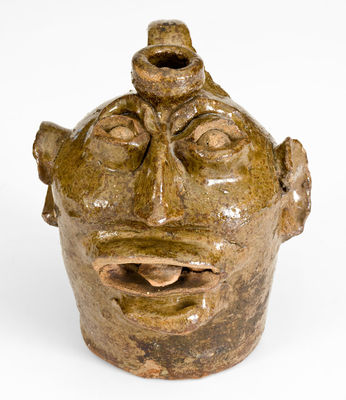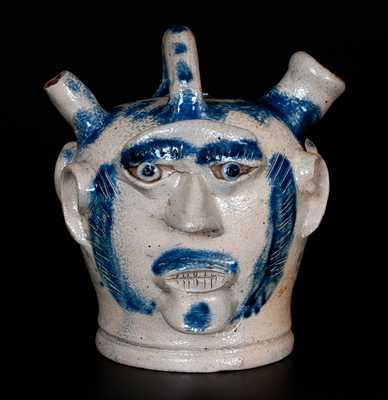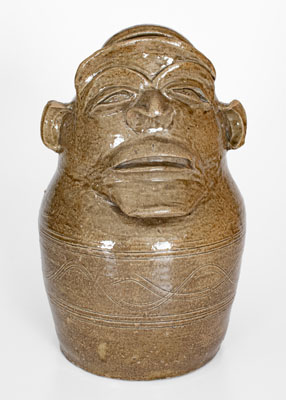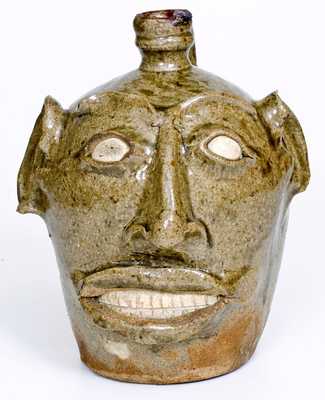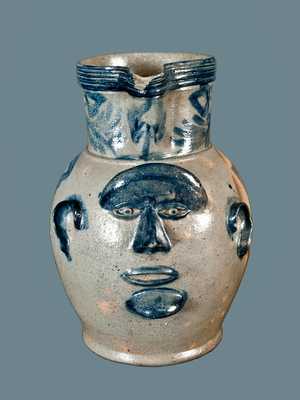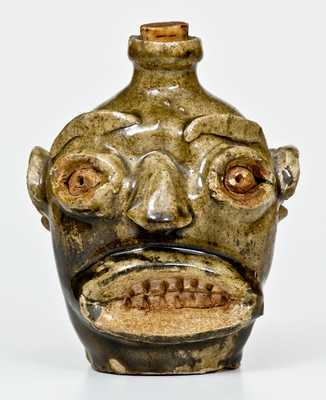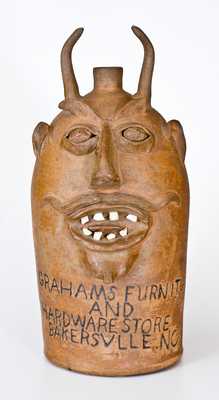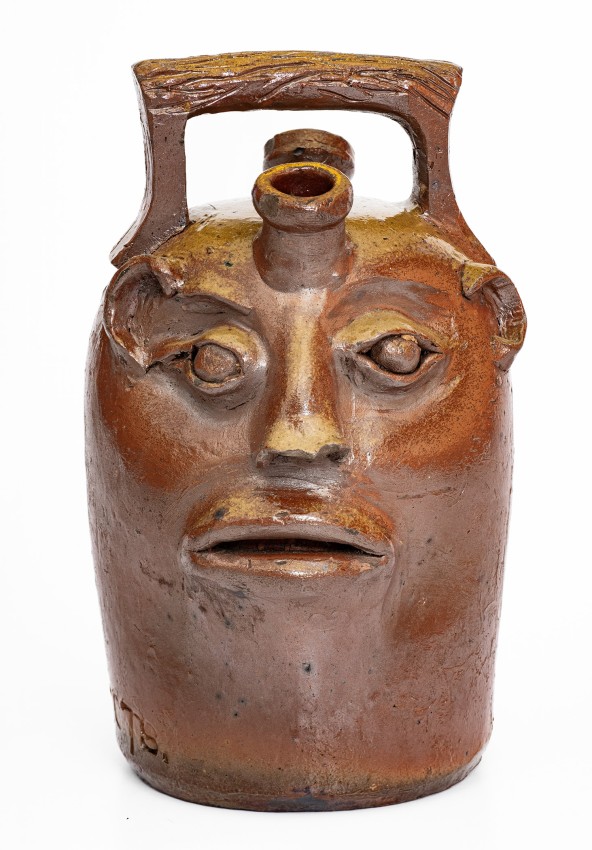Very Rare and Important Large-Sized Southern Stoneware Face Vessel of an African-American Preacher, Rock Mills, Alabama School, circa 1880-1890, wheel-thrown figure with clasped hands and brimmed hat, the face with applied and incised features, including eyes with impressed pupils, thick eyebrows with incised hair, a large mouth with incised teeth, a chin, and ears with pierced centers. Reverse of head with applied and lightly-depressed clay representing hair. The figure's hat is wheel-thrown and applied, with heavily-incised rings around the brim, sides, and top. An incised cross on the reverse may represent an individual potter's signature or simply indicate the figure's Christian faith. A circular opening in the reverse, carved prior to the sculpture's firing, is possibly a vent hole to prevent damage during the firing process; it may have also served as a flower holder or granted access to the interior for storage. The figure's robust arms include well-defined fingers and impressed finger nails. Two small impressed holes in the underside of each arm likely served as vents during the firing. Surface covered in a streaky Albany slip glaze, with additional red cold-painted highlights to lips, hat, and eyebrows. John Michael Vleck, in his 1978 book, The African-American Tradition in Decorative Arts, studies a figure likely by the same maker. With similar form, size, facial structure, and virtually identical hat, Vleck describes this second example as "the masterwork among known ceramic torso figures". Vleck writes, "The best of the Alabama trio is called Preacher Man. It is a bulky figure more than sixteen inches high. Lacking a spout or lid, it is a functional vessel and can more easily be interpreted as a graveyard decoration. The torso section of the figure, in fact, has the same bell shape as ceramic supports for grave markes made in Alabama and Mississippi. As in the previously described piece, the hands are folded at the waist. The head is also topped with a hat, but in this case it is an exquisitely style skimmer. ... The face is impressively molded with eyes sockets that penetrate into the empty hollow center of the sculpture. The lips are wide and the nose broad in an apparent attempt to represent facial features. The overall handling of mass and form in this piece is so impressive that it stands out as the masterwork among known ceramic torso figures. One scholar has remarked that the statue projects a kind of sympathy for a black subject. If, indeed, the figure was meant to depict a black man or preacher, it is a competent and well-executed statement. Since the features of this piece tend to favor abstract presentation over naturalism, it might be classed as a black creation. It is not clear how one safely measures such an intangible as ethnicity in a mute work whose only history is rumor. More information here would be helpful, but it would not be surprising to discover Afro-American origins." (Vleck, pp. 92-93) The vessel Vleck is referring to was previously owned by prominent New York folk art collector, John Gordon, and sold in an auction of his collection at Christie's, New York in 1999. It is pictured in Vleck's book, The African-American Tradition in Decorative Arts, as well as Robert Charles Bishop's well-known book, American Folk Sculpture. As stated, a number of clear stylistic similarities link this face vessel to the example offered at Crocker Farm, Inc., in July. However, the face on the vessel to be auctioned is arguably more well-executed and expressive. Perhaps the greatest single difference between the two sculptures is the construction of the eyes. Gordon's example features sunken eyes assuming a somber tone. The eyes on the newly-discovered figure are bulging and lively with impressed pupils, creating a more pleasant or satisfied visage to the preacher. In addition, this figure's mouth, with its pinched, upward curling ends, creates a sort of smile, which is markedly different than the mouth of the Gordon example. Few American face vessels of this size and quality are ever made available on the secondary market. Even fewer can be described as new discoveries, unknown until only months ago. Most examples from the North, South, and Midwest, were collected decades ago, now part of major public and private folk art collections throughout the country. One of the most significant American stoneware face vessel discoveries of the past several years. Provenance: Recently found in a garage in the Chattahoochee River Valley. Literature: For similar examples, see Christie's, Jan. 15, 1999, The John Gordon Sale of Folk Americana, lots 1167 and 1168; see also p. 220, fig. 412 of American Folk Sculpture by Robert Charles Bishop. For more information on Alabama face vessels and additional photos of similar examples, see also pp. 92-93 of The African-American Tradition in Decorative Arts by John Michael Vleck, University of Georgia Press, 1978. Two large losses to hat. A very stable, in-the-firing separation at wrist. Minor chips to one eye and minor wear to edge of one nostril. Small chips to opening on reverse. H 16 3/4".













